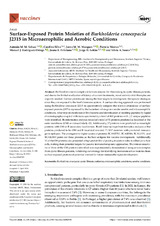Mostrar el registro sencillo del ítem
Surface-Exposed Protein Moieties of Burkholderia cenocepacia J2315 in Microaerophilic and Aerobic Conditions
| dc.contributor.author | Seixas, António M.M. | |
| dc.contributor.author | Silva, Carolina | |
| dc.contributor.author | Marques, Joana M. M. | |
| dc.contributor.author | Mateus, Patrícia | |
| dc.contributor.author | Rodríguez-Ortega, Manuel J. | |
| dc.contributor.author | Feliciano, Joana R. | |
| dc.contributor.author | Leitão, Jorge H. | |
| dc.contributor.author | Sousa, Sílvia A. | |
| dc.date.accessioned | 2024-04-10T08:03:50Z | |
| dc.date.available | 2024-04-10T08:03:50Z | |
| dc.date.issued | 2024 | |
| dc.identifier.uri | http://hdl.handle.net/10396/27851 | |
| dc.description.abstract | Burkholderia cepacia complex infections remain life-threatening to cystic fibrosis patients, and due to the limited eradication efficiency of current treatments, novel antimicrobial therapies are urgently needed. Surface proteins are among the best targets to develop new therapeutic strategies since they are exposed to the host’s immune system. A surface-shaving approach was performed using Burkholderia cenocepacia J2315 to quantitatively compare the relative abundance of surface-exposed proteins (SEPs) expressed by the bacterium when grown under aerobic and microaerophilic conditions. After trypsin incubation of live bacteria and identification of resulting peptides by liquid chromatography coupled with mass spectrometry, a total of 461 proteins with ≥2 unique peptides were identified. Bioinformatics analyses revealed a total of 53 proteins predicted as localized at the outer membrane (OM) or extracellularly (E). Additionally, 37 proteins were predicted as moonlight proteins with OM or E secondary localization. B-cell linear epitope bioinformatics analysis of the proteins predicted to be OM and E-localized revealed 71 SEP moieties with predicted immunogenic epitopes. The protegenicity higher scores of proteins BCAM2761, BCAS0104, BCAL0151, and BCAL0849 point out these proteins as the best antigens for vaccine development. Additionally, 10 of the OM proteins also presented a high probability of playing important roles in adhesion to host cells, making them potential targets for passive immunotherapeutic approaches. The immunoreactivity of three of the OM proteins identified was experimentally demonstrated using serum samples from cystic fibrosis patients, validating our strategy for identifying immunoreactive moieties from surface-exposed proteins of potential interest for future immunotherapies developmen | es_ES |
| dc.format.mimetype | application/pdf | es_ES |
| dc.language.iso | eng | es_ES |
| dc.publisher | MDPI | es_ES |
| dc.rights | https://creativecommons.org/licenses/by/4.0/ | es_ES |
| dc.source | Seixas, A.M.M.; Silva, C.; Marques, J.M.M.; Mateus, P.; Rodríguez-Ortega, M.J.; Feliciano, J.R.; Leitão, J.H.; Sousa, S.A. Surface- Exposed Protein Moieties of Burkholderia cenocepacia J2315 in Microaerophilic and Aerobic Conditions. Vaccines 2024, 12, 398. | es_ES |
| dc.subject | Burkholderia cenocepacia | es_ES |
| dc.subject | Cystic fibrosis | es_ES |
| dc.subject | Surfomics | es_ES |
| dc.subject | Microaerophilic conditions | es_ES |
| dc.subject | Aerobic conditions | es_ES |
| dc.title | Surface-Exposed Protein Moieties of Burkholderia cenocepacia J2315 in Microaerophilic and Aerobic Conditions | es_ES |
| dc.type | info:eu-repo/semantics/article | es_ES |
| dc.relation.publisherversion | https://doi.org/10.3390/vaccines12040398 | es_ES |
| dc.rights.accessRights | info:eu-repo/semantics/openAccess | es_ES |

